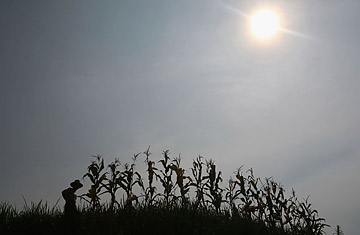
It can be difficult in the middle of winter — especially if you live in the frigid Northeastern U.S., as I do — to remain convinced that global warming will be such a bad thing. Beyond the fact that people prefer warmth to cold, there's a reason the world's population is clustered in the Tropics and subtropics: warmer climates usually mean longer and richer growing seasons. So it's easy to imagine that on a warmer globe, the damage inflicted by more frequent and severe heat waves would be balanced by the agricultural benefits of warmer temperatures.
A comforting thought, except for one thing: it's not true. A study published in the Jan. 9 issue of Science shows that far from compensating for the damages associated with climate change (heavier and more frequent storms, increasing desertification, sea-level rise), hotter temperatures will seriously diminish the world's ability to feed itself. David Battisti, an atmospheric scientist at the University of Washington, and Rosamond Naylor, director of the Program for Food Security and the Environment at Stanford University, analyzed data from 23 climate models and found a more than 90% chance that by the end of the century, average growing-season temperatures would be hotter than the most extreme levels recorded in the past. (See the top 10 green stories of 2008.)
That means that barring a swift and sudden reduction in greenhouse-gas emissions, by the end of the century an average July day will almost certainly be hotter than the hottest heat waves we experience now. And the extreme heat will wilt our crops. Battisti and Naylor looked at the effect that major heat waves have had on agriculture in the past — like the ruthless heat in Western Europe during the summer of 2003 — and found that crop yields have suffered deeply. In Italy, maize yields fell 36% in 2003, compared with the previous year, and in France they fell 30%. Similar effects were seen during a major heat wave in 1972, which decimated farms in the former Soviet Union, helping push grain prices to worryingly high levels. If those trends hold in the future, the researchers estimate that half the world's population could face a climate-induced food crisis by 2100. "I'm very concerned," says Naylor. "How are we going to feed a world of 8 or 9 billion with the effects of climate change?"
It's true that as temperatures warm, there is likely to be a temporary beneficial effect on agriculture. Like people, plants generally prefer warmth to cold, and they may flourish with rising levels of CO2. But research from Wolfram Schlenker at Columbia University shows that, as average temperatures continue to warm, those benefits dwindle and eventually reverse, and crop yields begin to decline. "It simply becomes too hot for the growing plants," says Naylor. "The heat damages the crops' ability to produce enough yield."
What's more, in their study, Battisti and Naylor looked only at the effect of higher temperatures — not at the possible effect of changing precipitation patterns. Yet many climatologists believe that global warming will make dry areas dryer and further damage farming, which is especially dire news for sub-Saharan Africa, a region that already struggles with heat waves, droughts and famines even as population continues to grow. "Climate change is going to be a major concern for Africa," says Nteranya Sanginga, director of the Tropical Soil Biology and Fertility Institute of the International Center for Tropical Agriculture in Nairobi. "We could lose whole growing seasons."
With these frightening predictions in mind, we need to try to heat-proof our agriculture. That can be accomplished by using crops that have proved resistant to extreme heat — like sorghum or millet — to breed hybrid-crop varieties that are more capable of withstanding higher temperatures. We'll need to drop any squeamishness about consuming genetically modified crops. Unless we can tap the power of genetics, we'll never feed ourselves in a warmer world. But we'll need to act quickly. It can take years to breed more heat-resistant species, and investment in agricultural research has shriveled in recent years.
We also need to focus on improving the agricultural productivity of those parts of the world that have been left behind by the Green Revolution — like Africa, where average crop yields per acre remain well below those in Asia or the West. One simple way is to increase the amount of fertilizer available to African farmers. Sanginga notes that about 440 lb. (200 kg) of nitrogen fertilizer is generally needed to grow 5 tons (5,000 kg) of maize, but the average African farmer can afford only 8 lb. of fertilizer. We can also work on safeguarding the degraded soils of Africa, where almost 55% of the land is unsuitable for any kind of cultivated agriculture. Help is on the way: the African Soil Information Service is launching a real-time digital map of sub-Saharan Africa's soils, which should allow farmers and policymakers to make better use of the continent's agricultural resources. "Farmers need to know when to invest and when to hold back," says Sanginga, who is involved with the mapping project.
There's a limit, however, to our ability to adapt to climate change. We need to reduce carbon emissions sharply and soon. If we fail, a warmer future won't just be uncomfortable; it will be downright frightening. "We need to wake up and take care of this," says Naylor. "We won't have enough food to feed the world today, let alone tomorrow."
